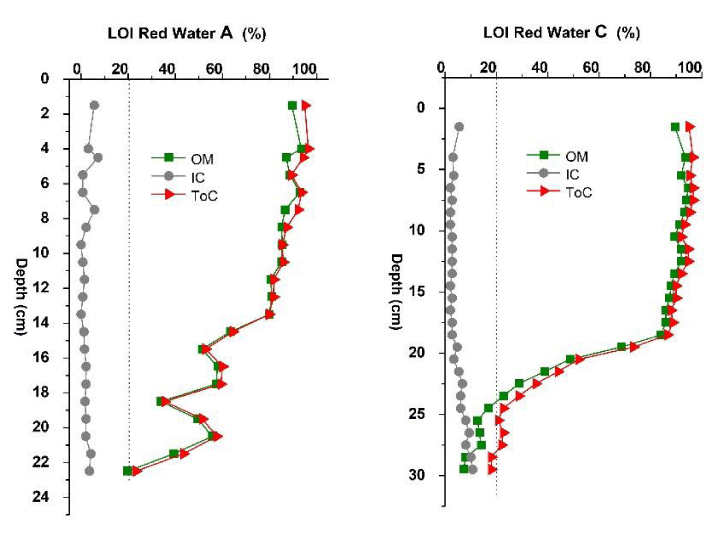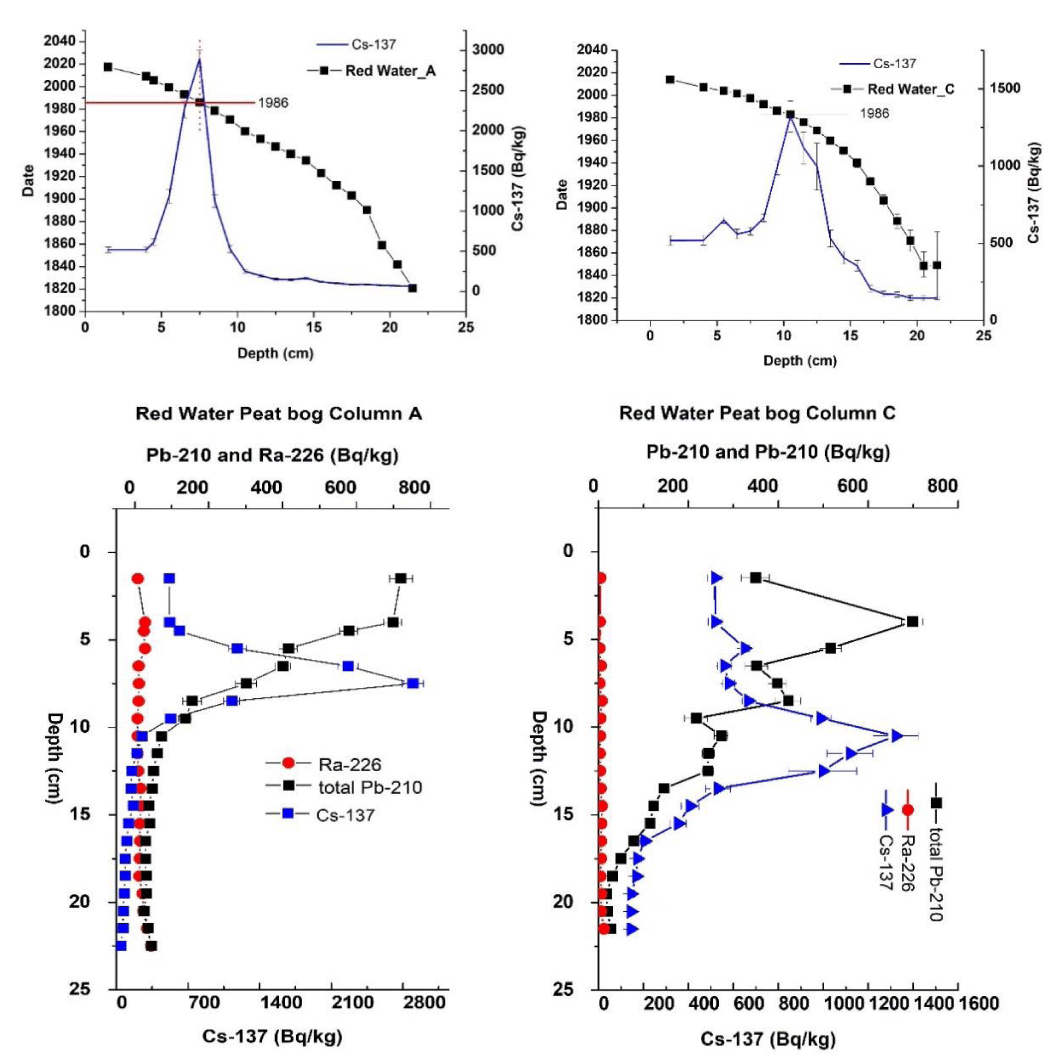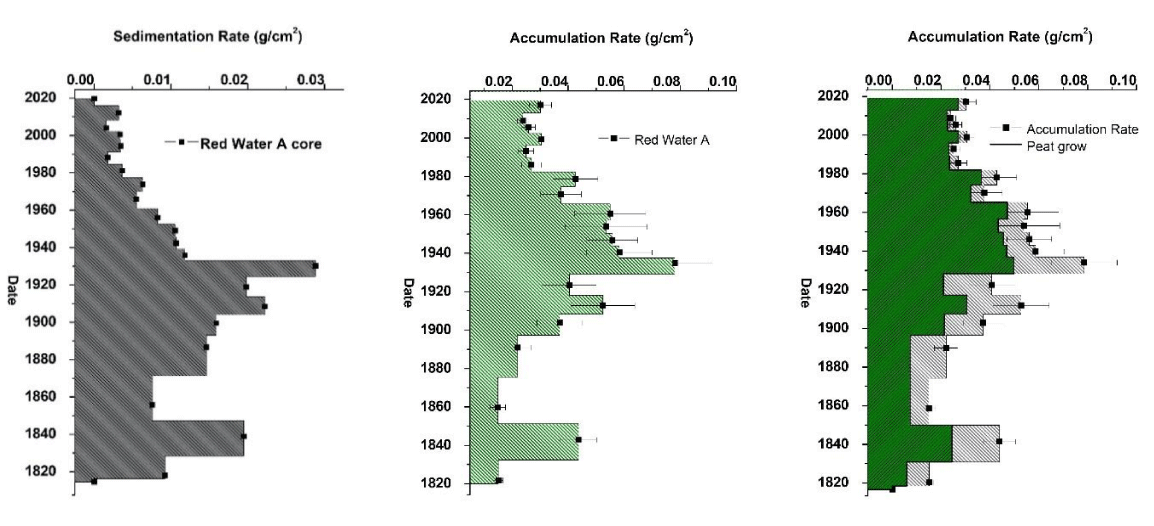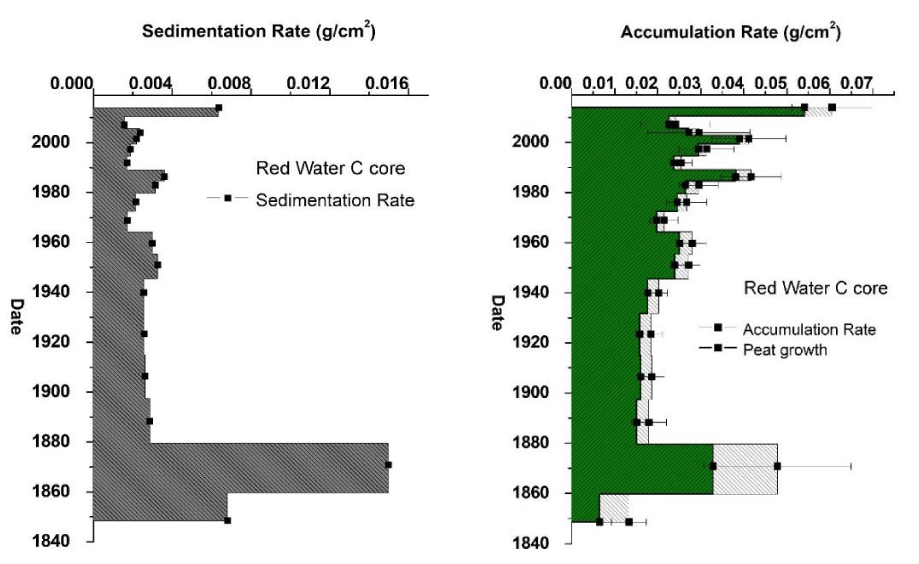Global Journal of Ecology
Investigation of the fingerprint of climate changes in the Tinovul Apa Roșie peat bog (central Romania) by using 210Pb dating method
Piroska Tóth1* and József Fazakas2
2Babes-Bolyai University, Cluj-Napoca, Romania
Cite this as
Tóth P, Fazakas J (2020) Investigation of the fingerprint of climate changes in the Tinovul Apa Roșie peat bog (central Romania) by using 210Pb dating method. Glob J Ecol 5(1): 018-023. DOI: 10.17352/gje.000014The object of our research was to investigate the peat mass accumulation mechanism, which reflects on wet and warmer periods, which stimulate the accumulation rate of peat bog production and colder, dry periods, when the peat growth is stagnant. In warm and dry periods, the peat can stop growing. This fluctuation in peat evolution reflects clearly the changes in climate (especially temperature and precipitation). Lake sediment and peat lands represent a large database for recent environmental changes. Changes in the intensity and periodicity of the geomorphological (erosion, sedimentation) and climate variations nowadays happen in a relatively short time interval. During this study the 210Pb dating method is used for dating peat deposits to collect data on peat growth and inorganic material deposition in the recent past, in correlation with microclimate changes in the Red Water valley (Apa Roșie, Covasna county, Romania). 137Cs and 210Pb measurements were performed using gamma spectrometry. 210Po measurements were done for calibration and to validate the gamma spectrometry results. Additionally, 137Cs measurements provided a useful independent time marker for validating the data obtained from the 210Pb dating. Two peat columns were collected from the Red Water (Tinovul Apa Roșie) peat bog from the center of Romania (Transylvania). The obtained results show that the peat accumulation starts from 1820, and in Core A the maximum growth period is between 1930-1960 with an average growth rate of 0.04±0.008 g/cm2y, while the inorganic sediment accumulation has two maximum values, the first in 1830, and the second in 1930, with 0.03±0.009 g/cm2y. Core C clearly shows the warming tendency in the local micro climate, which corresponds to an increase in the growth rate of the peat starting from 1900 from a value of 0.01±0.0009 to 0.04±0.008 g/cm2 y.
Introduction
The purpose of this research is to evaluate the fragility of the ecosystem of the Tinovul Apa Roșie peat bog, and the presence of the extreme weather events that this ecosystem has survived. Bogs are one of the most distinctive and specific habitat types amongst wetlands. The ombrotrophic (rain-fed) bogs get all their moisture from precipitation (rain, snow). Temperature and precipitation have a major impact on the hydrology of the bog. While precipitation induces the growth of the bog, changes of temperature affect the speed of its growth, meaning that the accumulation of bog is directly dependent on climate [1]. The vegetation composition, especially the dominant Sphagnum species significantly influence the peat accumulation rates. Peatlands are carbon accumulating ecosystems, where the primary production exceeds the organic matter decomposition rate in the soil, and therefore they perform an important sink function in global carbon cycle [2-4]. The dominant plants of A raised peat bog in a temperate climate zone are mosses of the genus Sphagnum that provide most of the organic matter, whereas the dominant plants on the fens (fed by mineral-rich surface water or groundwater) are represented by sedge [5,6].
Predicted future changes in climate with particular relevance to peatlands include
• Rising temperatures,
• Changes in the amount, intensity and seasonal distribution of rainfall,
• Reduced amount of snowfall at high altitudes, in mountain areas.
These changes will have a significant impact on the peatland’s carbon store, greenhouse gas fluxes as well as biodiversity. A low water level leads to a decrease of peatland surface and an increase of carbon emissions into the atmosphere, whereas a high-water level leads to an increase of peatland surface and carbon sequestration in peatlands [4].
The method of sequential Loss Ignition (LOI) is commonly used to estimate the organic matter content and carbonate minerals in sediments. The LOI method demonstrates the linear relations between organic and inorganic carbon content to identify the interface of peat sediment. The Loss on Ignition (LOI) of peat reflects the input of clastic material from overbank flooding [7], which suggests that vertical changes of LOI in peat represent changes in sedimentation rate. High-resolution measurements of the LOI in peat are readily obtainable and which provide a record of changes in the overbank sedimentation rate. Where the organic matter is above 20% in the sampled material, that is considered peat [8]. The composition of peat is highly variable [2]. It is generally composed of at least 65% organic matter (dry weight basis) and less than 20%-35% inorganic material, and it may be up to 95%-99% organic [9]. Taking this into consideration, LOI measurements helped us in the separation of the organic peat growth rate from the inorganic sediment accumulation rate (Figure 1).
210Pb dating is a key technique to study sedimentary records of environmental change in the Anthropocene over a time scale of 150–200 years [10]. The continuing existence of peatland ecosystems is endangered by climate change and direct anthropogenic pressures (e.g. drainage, pollution and extraction).
The radionuclides 210Po (T 1/2: 138 days) and 210Pb (T1/2: 22.3 years) are the final radioactive members of the 238U series and are widely present in the environment. The presence of 210Po and 210Pb in the sediments may be due to the decay of radionuclides in the 238U chain present in the sediment or due to the deposition of 222Rn (T1/2: 3.84 days) decay products. Unsupported 210Pb is deposited by wet and dry fallout. Normally, the estimated unsupported 210Pb from the total 210Pb inventory of a sediment section presents high values at the surface, decreasing with depth as a result of radioactivity decay [11]. Consequently, it is possible to establish age–depth models in sediment core sections, by quantifying the unsupported 210Pb inventory from the surface down to the bottom until the unsupported 210Pb becomes undetectable or negligible ) [12]. Influx of 210Pb to bog areas was determined to originate from natural and anthropogenic sources [13].
The constant rate of the 210Pb supply (CRS) model is often used to determine the ages and sedimentation rates of sub-samples of sediment layers. This model is used if the growth rate is not constant over time, but if it can be presumed that the rate of the unsupported 210Pb deposition is permanent [14-16] . Previous results showed that the 210Pb method is the most accurate technique for determining the age and accumulation rate of peat [17]. The artificial fallout radionuclide 137Cs data representing an independent chronomarker is usually included into 210Pb chronology graphs for validation [17-20]. Given the fact that radionuclides are significant aerosol tracers, it is important that we understand the cycling of 222Rn-210Pb, as this can help in the study of global aerosol-climate interaction [21].
Material and methods
Study area
The Tinovul Apa Roșie (Red Water) peat bog it is a natural protection site as part of the Natura 2000 ecological network (ROSCI 0242), in the north-eastern part of Covasna county Romania, in the Nemere Mountains, along the Apa Roșie stream at an altitude of 990-1030m. It is a natural area (deciduous forests, coniferous forests, mixed forests, transition forests, bushes, hedges, meadows, peatlands and marshlands) framed in the alpine bioregion of the southern slope of the Nemere Mountains (group of the Moldo-Transylvanian Carpathians region, belonging to the Oriental chain of the Carpathians). The highest point is peak Nemira Mare, with 1649m. The studied area has at present a subalpine climate.
Sampling
Peat samples were collected during early spring in 2018. Peat profiles were taken in the central area of the bog at two locations, sample A (46°10’46” N; 26°15’13” E) at an elevation of 990 m, and sample C (46°10’43” N; 26°15’15” E) at an elevation of 1000 m using a Wardenaar corer (10 cm×10 cm×100 cm). Both monoliths were approximately 45 cm long.
Each of the bog cores was sub-sampled into 1 cm slices with a stainless steel knife, the sections were placed into plastic bags, and transported to the laboratory. Each sub-sample was dried in a drying oven at 105°C, until constant mass was obtained. After grinding, sieving and homogenization, the samples were stored in the laboratory for α and γ spectrometric measurements. LOI (Loss on Ignition) measurements were performed to determine the Organic Mass (OM) and carbonate content (IOC) at 350°C and 750°C respectively, the sum of the two (OM and IOC) giving the Total carbon content (TOC).
Loss on Ignition (LOI)
1.5g aliquots of homogenized peat sample were measured into ceramic crucibles, weighted together, then they were heated to 350°C and kept there for 3 hours. After 3 hours the weight of the crucibles were measured again followed by heating to 750°C for 3 hours and finally their weight was measured for the third time. LOI analysis shows that we have peat accumulation above 22 and 25 cm in the sampling columns respectively (Figure 1).
210Pb chronology
Gamma spectrometry: Samples for gamma spectrometric measurements were placed in cylindrical aluminum containers (with 6 cm diameter and 1cm height) and sealed to avoid the 222Rn loss. Samples were then stored for 28 days, until the secular equilibrium between 226Ra and 222Rn was established. High resolution γ spectrometric analyses were carried out using an ORTEC GMX type HPGe detector. Total 210Pb and in situ 210Pb (226Ra) were analyzed, 210Pb by using the 46.5 keV line, and 226Ra was measured through the 352 keV gamma line of 214Pb. For the determination of 137Cs concentration the 661.7 keV gamma line was used.
Alpha-particle spectrometry: The total 210Pb content was measured via alpha spectrometry, through 210Po, by the chemical separation of the isotope from the sediment matrix and from the other alpha emitters. For each 0.5 g of dried homogenized bog sample, 0.3 ml of 209Po tracer (with 30 mBq/ml activity) was added, in order to determine the chemical yield. Acid digestion was carried out by using 20 ml of concentrated HNO3 in three subsequent steps; each time the sample was evaporated until near-dryness. Next, 20 ml of concentrated HCl was added, and evaporated to near-dryness three times. For the elimination of organic matter a few drops of H2O2 were added. Finally, in order to eliminate the acids, 20 ml of distilled water was added and evaporated until near-dryness, also repeated 3 times. The 210Po sources were prepared by spontaneous deposition on the surface of stainless steel discs (ø=2.5 cm) from a HCl acid medium at pH 0.5–1 at 85°C temperature for 3 h. Interfering ions (Fe-ions) were eliminated by adding ascorbic acid to form iron complexes. For calibration IAEA-447 (moss soil) standard was used, and measurements of 210Po were performed for validating the gamma measurement results. The obtained sources were measured by an ORTEC SOLOIST 900 mm2 PIPS detector (19 keV resolution) connected to an ASPEC-92 data acquisition system.
The age depth model was derived by applying the 210Pb dating method utilizing the alpha and gamma-spectrometry data. The CRS model was used to calculate the age and the sedimentation rate in the samples.
Results and discussion
The 210Pb dating method and the 137Cs validation was carried out on peat bog samples from Tinovul Apa Roșie, Romania. This area was assessed for the first time by alpha and gamma spectrometric analysis, which were carried out to measure the radionuclides of interest (210Pb/210Po, 226Ra and 137Cs) in the peat sediments. The Chernobyl maximum was identified in the normalized 137Cs activity profile. The activity ratios of anthropogenic radionuclides allow for the identification of sources. The geochronology of the sediment layers and the sedimentation rates were assessed to characterize the peat growth processes involved in the evolution of the Tinovul Apa Roșie. Our results also confirmed that the 210Pb method is an accurate technique for determining the age and accumulation rate of a peat.
Sedimentation rates
The peat mass accumulation rate is considered an indicator of wet and warmer periods, which stimulate the accumulation rate of peat bog production, and colder, dry periods, when the peat growth is stagnant. In warm and dry periods, the peat can stop growing entirely. This fluctuation in peat growth reflects the changes in climate (especially temperature and precipitation). The inorganic sedimentation rate reflects the influx of inorganic material, such as flooding.
LOI analysis shows the peat accumulation over 22 and 25 cm in Core A and C, over the base mud layer.
Analyzing the sedimentation of Core A, one peak is evident, providing information about the past hydrological events, namely the floods of 1937–1940 [21]. The values for mass sedimentation exceed 0.04±0.008 g/cm2y. The inorganic sediment accumulation has two maximum values, the first in 1830 and the second in 1940 with 0.03±0.009 g/cm2y. The 1940 event probably reflects the flooding mentioned before, however there is no readily available data on the circumstances of the 1830 event. Instrumental records of monthly air temperature and precipitation are available only for the last 58 years (1961–2018) from the city of Miercurea Ciuc in central Romania (40 km from the study area) from the Romanian National Meteorological Administration (www.meteoromania.ro).
Core C was taken from a higher elevation than Core A. In Core C the warming tendency in the local micro climate is clearly visible, which corresponds to an increasing growth rate of the peat, starting from 1900 from a value of 0.01±0.0009 to 0.04±0.008 g/cm2 y. Global and regional data on temperature and precipitation to be compared is available only from the beginning of the 20th century, according to which in both cases the average temperature rise was between 0.5 and 1.1°C [22-28], (NOAA). In the last decades in the summer vegetative period there was an increase in temperature and precipitation, which is reflected in the peat growth rate.
The radionuclide concentration (Figure 2) of 210Pb shows an exponential decrease with the depth and can be used for radiometric age determination. For age calculation the Constant Rate of Supply model was used with minor modifications. The age obtained from 210Pb dating for 1986 are clearly proved by the 137Cs concentration originating from the Chernobyl event found in the sampled peat columns (Figure 3a,b). The peat growth rate was separated (extracted from the total value) from inorganic sediment deposition using the LOI results. Some flooding periods can be identified in Core A, which was taken close to the Apa Roșie (Red Water). Core A shows relatively constant peat growth, except one time interval. In Core C the peat accumulation constantly increases starting from 1900, which is a clear consequence of micro climate changes in the Tinovul Apa Roșie (Red Water) peat bog.
Conclusion
Based on our research the relationship between climate and peatland distribution suggests a strong possible influence of future climate change on peatlands.
The higher sedimentation rate of 1940±5 is the result of a flood that modified the growth of peat in Core A. This growth is not present in Core C due to the difference in altitude. (Core A 990m and Core C 1000m). In the Core C the warming tendency in the local micro climate is clearly visible, which corresponds to an increasing peat growth rate. The results of the last 100-150 years suggest fast and significant changes in the flora and fauna of the geographical location, showing a pronounced degradation effect on the peatland ecosystem. Therefore, this unique geographical location deserves full scientific interest. The obtained high-resolution data on the Tinovul Apa Roșie (Red Water) peat bog, including the radioisotope concentrations, can serve as a regional benchmark for similar studies, and these data also showcase how peat bogs can constitute powerful tools to study atmospheric deposition.
- Cristea G, Cuna SM, Fărcaş S, Tanţău I, Dordai E, et al. (2014) Carbon isotope composition as indicator for climatic changes during the middle and late Holocene in a peat bog from Maramureş Mountains (Romania). The Holocene 24: 15–23. Link: https://bit.ly/2NGeGDI
- Clymo RS (1984) The Limits to Peat Bog Growth. Philosophical Transactions of the Royal Society B: Biological Sciences 303: 605–654. Link: https://bit.ly/2VwUiJq
- Whittle A, Gallego-Sala AV (2016) Vulnerability of the peatland carbon sink to sea-level rise. Sci Rep 6: 28758. Link: https://bit.ly/2D0RjCZ
- Taminskas J, Linkevičienė R, Šimanauskienė R, Jukna L, Kibirkštis G, et al. (2018) Climate change and water table fluctuation: Implications for raised bog surface variability. Geomorphology 304: 40–49. Link: https://bit.ly/38feUvb
- De Vleeschouwer F, Chambers FM, Swindles GT (2010) Coring and sub-sampling of peatlands for palaeoenvironmental research. Mires and Peat 7: 1–10. Link: https://bit.ly/3eTuoaA
- Le Roux G, Aubert D, Stille P, Krachler M, Kober B, et al. (2005) Recent atmospheric Pb deposition at a rural site in southern Germany assessed using a peat core and snowpack, and comparison with other archives. Atmospheric Environment 39: 6790–6801. Link: https://bit.ly/2CXYY4R
- Davies-Vollum KS, Smith ND (2008) Factors Affecting the Accumulation of Organic-Rich Deposits in a Modern Avulsive Floodplain: Examples from the Cumberland Marshes, Saskatchewan, Canada. J Sediment Res 78: 683–692. Link: https://bit.ly/3dNjjqh
- Ishii Y, Hori K, Momohara A (2017) Middle to late Holocene flood activity estimated from loss on ignition of peat in the Ishikari lowland, northern Japan. Global and Planetary Change 153: 1-15. Link: https://bit.ly/2BUwgBr
- De Vleeschouwer F, Gérard L, Goormaghtigh C, Mattielli N, Le Roux G, et al. (2007) Atmospheric lead and heavy metal pollution records from a Belgian peat bog spanning the last two millenia: Human impact on a regional to global scale. Sci Total Environ 377: 282–295. Link: https://bit.ly/3f1llVj
- Begy RC, Kovacs T, Veres D, Simon H (2016) Atmospheric flux, transport and mass balance of 210Pb and 137Cs radiotracers in different regions of Romania. Applied Radiation and Isotopes 111: 31–39. Link: https://bit.ly/2VAuV9H
- Appleby PG, Oldfield F (1983) The assessment of 210Pb data from sites with varying sediment accumulation rates. Hydrobiologia 103, 29–35. Link: https://bit.ly/3dRBhYy
- Ali AA, Ghaleb B, Garneau M, Asnong H, Loisel J (2008) Recent peat accumulation rates in minerotrophic peatlands of the Bay James region, Eastern Canada, inferred by 210Pb and 137Cs radiometric techniques. Applied Radiation and Isotopes 66: 1350–1358. Link: https://bit.ly/2BW9N6M
- Vaasma T, Karu H, Kiisk M, Pensa M, Isakar K, et al. (2017) Pb-210 and fly ash particles in ombrotrophic peat bogs as indicators of industrial emissions. Journal of Environmental Radioactivity 174: 78–86. Link: https://bit.ly/3dLMNVh
- Appleby PG (2008) Three decades of dating recent sediments by fallout radionuclides: A review. Holocene. https://bit.ly/3dOxOKq
- Begy RC, Timar-Gabor A, Somlai J, Cosma C (2011) A sedimentation study of st. ana lake (Romania) applying the 210Pb and137Cs dating methods. Geochronometria. Link: https://bit.ly/3dNjK3T
- Simon H, Kelemen S, Begy R (2017) Anthropic influences on the sedimentation rates of lakes situated in different geographic areas. Journal of Environmental Radioactivity. Link: https://bit.ly/31AyWyK
- Mróz T, Łokas E, Kocurek J, Gąsiorek M (2017) Atmospheric fallout radionuclides in peatland from Southern Poland. Journal of Environmental Radioactivity 175–176: 25–33. Link: https://bit.ly/2BPlnAJ
- Pennington W, Tutin TG, Cambray RS, Fisher EM (1973) Observations on Lake Sediments using Fallout 137Cs as a Tracer. Nature 242: 324-326. Link: https://go.nature.com/3ijiM2M
- Smith JN (2001) Why should we believe 210Pb sediment geochronologies? J Environ Radioact 55: 121–123. Link: https://bit.ly/38iBZgr
- Walling DE, Zhang Y, He Q, Ex UK (2002) Models for Converting Measurements of Environmental Radionuclide and Deposition Rates ( Including Software for Model Implementation ). Development 1-32. Link: https://bit.ly/2NMrQ1Y
- Li C, Le Roux G, Sonke J, Van Beek P, Souhaut M, et al. (2017) Recent 210Pb, 137Cs and 241Am accumulation in an ombrotrophic peatland from Amsterdam Island (Southern Indian Ocean). J Environ Radioact 175–176: 164–169. Link: https://bit.ly/2YOk9ij
- Mateescu E, Smarandache M, Jeler N, Apostol V (2013) Drought conditions and management strategies in Romania. Link: https://bit.ly/2Zo0HI5
- Micu DM, Dumitrescu A, Cheval S (2014) Climate of the Romanian Carpathians: Variability and Trends. Springer.
- Wardenaar CP (1987) A new hand tool for cutting peat profiles, Can J Bot 65: 1772-1773. Link: https://bit.ly/2YP2h6R
- https://bit.ly/38jfdVu
- Link: https://bit.ly/2Zrc4PG
- NOAA National Centers for Environmental Information (2020) State of the Climate: Global Climate Report for Annual 2019. Link: https://bit.ly/3gjluDH
- PG A (2001) Basin analysis, coring and chronological techniques, development in paleoenvironmental research. Kluwer Academic Publishers Appleby PG 576.
Article Alerts
Subscribe to our articles alerts and stay tuned.
 This work is licensed under a Creative Commons Attribution 4.0 International License.
This work is licensed under a Creative Commons Attribution 4.0 International License.





 Save to Mendeley
Save to Mendeley
